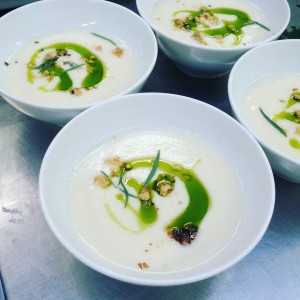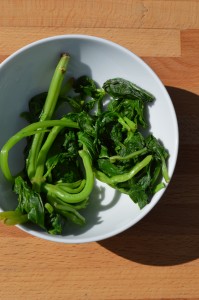 Herb oil is a powerful tool to have in your culinary belt.
Herb oil is a powerful tool to have in your culinary belt.
It is a fantastic way to preserve a glut of herbs, especially a glut of herbs that are past their prime, for instance basil that is starting to get moist and speckled. This less-than-attractive basil still has loads of flavour. And parts of the herb that are usually discarded, say the thick, woody stem of a basil plant, are also full of flavour, and make great herb oil. Herb oil keeps for weeks in the fridge and months in the freezer, and if made properly it is a stunning, concentrated, lustrous, fluid version of the plant it is made from.
My herb oil process is ripped directly from The French Laundry Cookbook. There are a few pages devoted to herb oils in that influential tome.
You can make oil from almost any herb, but to me fine aromatic herbs (have I mentioned basil yet?) make the best oils. Resinous herbs like thyme and rosemary will make flavourful oil, but not with the striking, vibrant green of their more delicate relatives. I usually add a bit of parsley or carrot tops when making oils with resinous herbs; it will dilute the flavour slightly, but brighten the green colour.
 Blanching. We always blanche herbs before making oil. Blanching means cooking quickly in boiling water. In this case it is entirely aesthetic. For a detailed description of how blanching improves the colour of green plants, please see this post.
Blanching. We always blanche herbs before making oil. Blanching means cooking quickly in boiling water. In this case it is entirely aesthetic. For a detailed description of how blanching improves the colour of green plants, please see this post.
While green vegetables like broccoli might be blanched for a few minutes, herbs only need about thirty seconds.
After blanching, the herbs should be dunked in ice water to arrest the cooking process. After chilling, press the herbs with a dish towel to remove as much water as possible.
Blitzing. Put the blanched herbs into a blender, and add just enough oil so that the blender can cycle the mixture and cut the herbs fine. The higher your ratio of herbs to oil, the better the colour and flavour of your finished herb oil will be.
I use neutral canola oil, as I want the finished product to taste purely of the herb. Depending on the final application, you can certainly use other, more flavourful oils like olive or flax.
Blitz the herbs for at least a few minutes. The more you destroy the herbs cells walls, the better your extraction will be, and the more flavourful your oil.
Infusion Period. If you’re hardcore you’ll leave your herb slurry in the fridge overnight to extract as much flavour from the herbs into the oil as possible.
Straining. Pour the herb slurry into a chinois, a fine mesh strainer, and let it drip filter. Don’t press the slurry to force the oil through, as this will let small particles through that will cloud your oil.
Storage. Best stored in the fridge or even the freezer to preserve the fresh aroma and flavour of the herbs. These oils can also be sensitive to light. One afternoon I left a beautiful verdant basil oil on the kitchen counter in direct sunlight. By dinner time it was brown.
Use. I don’t know if serious chefs still do this, but I love floating oil on top of soups: pumpkinseed oil on squash soup, tarragon oil on parsnip pear soup (pictured above), basil oil on tomato soup. It’s a great way to feature the oil, which can get lost in, say, a salad.